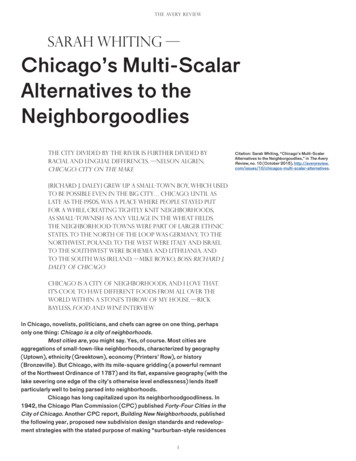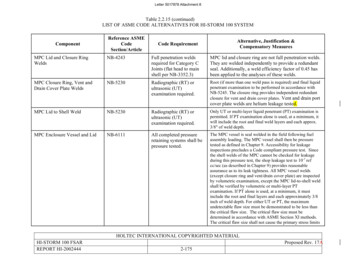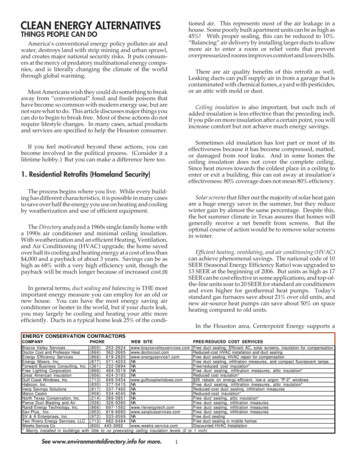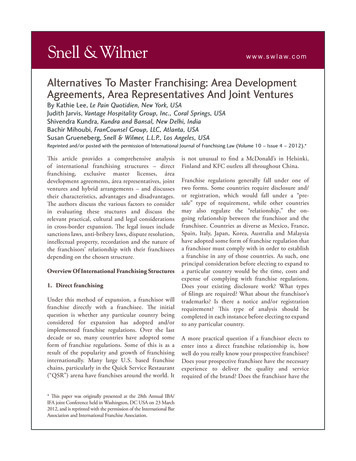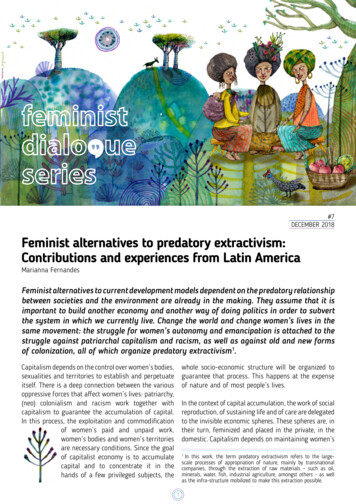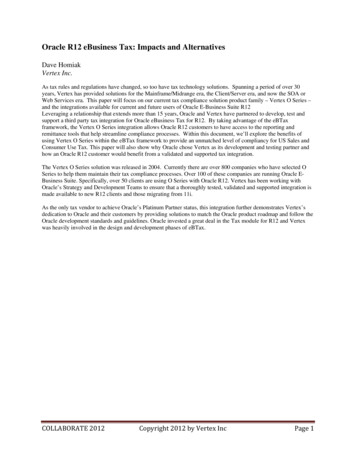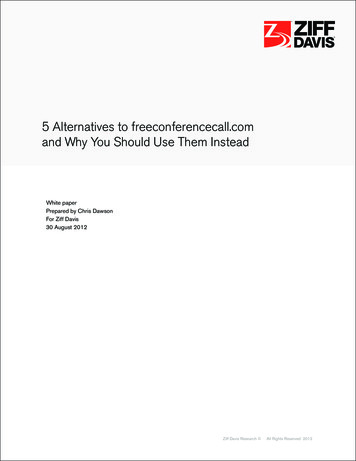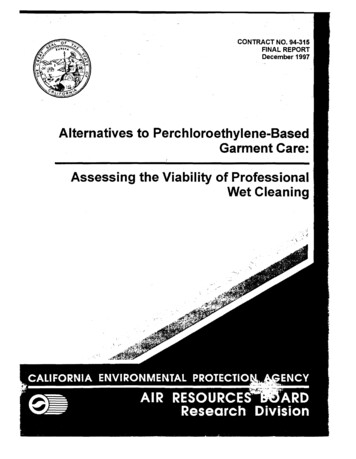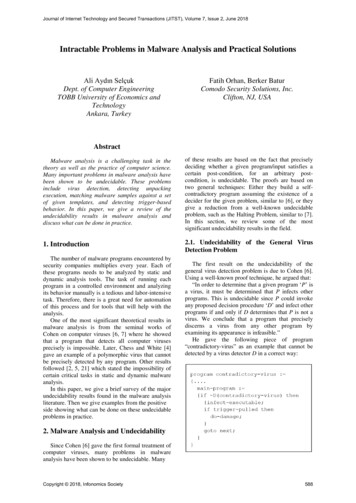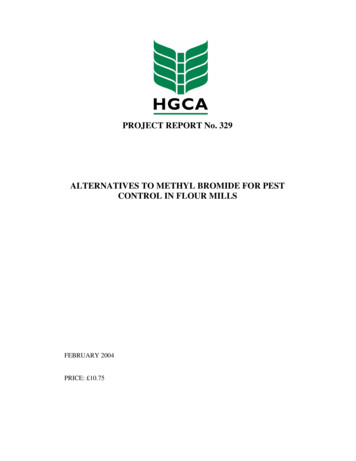
Transcription
PROJECT REPORT No. 329ALTERNATIVES TO METHYL BROMIDE FOR PESTCONTROL IN FLOUR MILLSFEBRUARY 2004PRICE: 10.75
PROJECT REPORT No. 329ALTERNATIVES TO METHYL BROMIDE FOR PESTCONTROL IN FLOUR MILLSbyC H Bell1, D Bartlett2, S T Conyers1, D A Cook1, N Savvidou1 and T JWontner-Smith112Central Science Laboratory, Sand Hutton, York YO41 1LZADAS Boxworth, Battlegate Road, Boxworth, Cambs CB3 8NNThis is the final report of a thirty-nine month project that started in July 2000. Theresearch was funded under the MAFF (now Defra) LINK scheme (Project AFM-93)with the following grants: Defra - 90,000; HGCA - 135,000 (Project No. 2301);National Association of British and Irish Millers (in kind) - 27,000; Igrox Ltd. (inkind) - 18,000.The Home-Grown Cereals Authority (HGCA) and other sponsors have provided fundingfor this project but have not conducted the research or written this report. While theauthors have worked on the best information available to them, neither HGCA nor theauthors shall in any event be liable for any loss, damage or injury howsoever suffereddirectly or indirectly in relation to the report or the research on which it is based.Reference herein to trade names and proprietary products without stating that they areprotected does not imply that they may be regarded as unprotected and thus free for generaluse. No endorsement of named products is intended nor is it any criticism implied of otheralternative, but unnamed, products.
CONTENTSABSTRACT1SUMMARY2BACKGROUND2EXPERIMENTAL DEVELOPMENT2FIELD TRIAL SUMMARIES6TECHNICAL DETAIL12GENERAL INTRODUCTION12SELECTION OF HEATER13HEAT IN COMBINATION13USE OF DUSTS14SECTION A: LABORATORY AND DEVELOPMENTAL STUDIESMODELLING OF THERMAL PERFORMANCE1414PRACTICAL ASPECTS OF HEATING STRUCTURES ANDTEMPERATURE MEASUREMENT17THE RESPONSE OF INSECTS TO HEAT EXPOSURES23TABLES AND FIGURES FROM INSECT TESTS31SECTION B. DESCRIPTION OF TRIALS391. MILL STRUCTURAL HEATING TRIAL AT HULL392. MILL HEATING TRIAL AT STUTTGART 23/24 NOV. 2001433. TRIAL AT LANGLEY MILL, NOTTS494. RAINHAM BRAN HOUSE TRIAL545. TRIALS AT BOXWORTH626. MILL BASEMENT HEATING TRIAL, CAMBRIDGE727. WHOLE MILL TRIAL AT HOLBEACH82REFERENCES95APPENDIX 1. DETAILS OF MILL HEATING THERMAL MODELLING98APPENDIX 2. A SKELETON PROTOCOL FOR MILL HEAT TREATMENTi112
ABSTRACTPotential methods of using heat to disinfest flour mills were investigated.The effect of hightemperatures was assessed against ten pest species of flour and flour mills, Ephestia kuehniella,Tribolium castaneum, T. confusum, Cryptolestes turcicus, Ptinus tectus, Sitophilus granarius,Gnatocerus cornutus, Tenebrio molitor, Liposcelis bostrychophila and Acarus siro, in the presence andabsence of modified atmospheres and inert dusts. Temperatures in excess of 47 C held for 24 h, or44oC held for 48 h, killed all stages of all the above mill pests. The presence of up to 30% carbondioxide in the atmosphere did little to reduce target temperatures or treatment times, but the efficacy ofinert dust treatments was significantly enhanced above 30oC achieving complete control of flour beetlesand grain weevils within 24h at 40oC at dosages down to 1 g/m2.Following pilot trials establishing structural component heating rates, maximal non-dust-entraining airmovement rates and atmosphere leakage rates, electrical heating of air in flour mills was accomplishedusing multiple commercial 18 kW 3 phase fan heaters distributed throughout the building. Insectactivity is greatly stimulated by increasing temperature and pests tend to emerge from harborages. Foreffective kill floors need to have become hot enough to kill any insects falling out of refuges in plantand upper structures. However basement floors are the hardest part of a structure to heat.To enable the heat requirement for practical heating trials in mills to be calculated, a computer modelwas developed to find an air temperature to simultaneously balance heat flows through up to 10different types of structure bounding a given volume. The model can predict the surface and internaltemperatures of structural elements and can simulate the thermostatic control of the heaters and heatmats. It can also predict energy costs.To provide the extra heat input required for wall floor joints, silicone rubber electric heating mats wereplaced in the ground floor area prior to the main air heating period while the mill was still running. Thisreduced the down-time of the mill for the treatment. Mats were covered with insulation and held inplace with sand snakes. When air heating was started, additional floor fans were positioned to blowwarm air over ground floor slabs to accelerate their heating and insulation was removed from the mats.The heating of upper floor wall floor joints was accomplished using fans and perforated polythene ductsfed from an available 18 kW heater. The trials demonstrated that with sufficient heaters and localknowledge of trouble areas, mills could be safely disinfested, but costs did exceed those for fumigation.1
SUMMARYBACKGROUNDThe principal objective of this programme was to find a viable alternative to the commercially importantfumigant methyl bromide, shortly to be restricted under the international Montreal Protocol agreementbecause of ozone depletion concerns, for dealing with infestation and hygiene problems in structuresused for food processing, in particular flour mills. The loss of methyl bromide will remove a majorsafeguard for the maintenance of food hygiene, increasing the risk of spreading problems arising atvarious points in the supply chain from the farm to commercial stores, mills, bakeries and retail outlets.It is thus of vital importance to develop viable alternatives to methyl bromide. In the absence ofalternatives, the only course of action would be to apply for a critical use exemption, but for this to beaccepted by the Technical and Economic Assessment Panel of the UNEP Montreal Protocol, it wouldhave to be shown that alternatives had been tried and had failed. The establishment of a soundtechnological basis for an alternative control procedure would result in rapid adoption by industryprovided that the changes necessary in commercial practice were economically feasible for the marketconcerned.Of the various non-chemical alternatives under investigation internationally, the one which appearsmost widely acceptable to the UK flour milling industry and which is sufficiently developed forrefinement and use in the immediate future, is treatment by heating. For the flour milling industry thedowntime and production loss arising from whole site treatments to combat pest problems has restrictedcontrol options to those which act most rapidly. This has been the reason for adopting methyl bromideas the mainstay for what has become in many cases an annual whole-site treatment strategy. Heat is oneof the few options offering rapid action but for heat treatments to be effective the problem is how torapidly achieve an even distribution of temperatures high enough to kill pests but low enough to avoiddamage to structural or electronic components. To address this problem the current programme wasstarted to investigate the effects of heating and other combinations, including inert dust application andatmosphere modifications, on the efficacy of high temperatures in achieving control within a 24-36htreatment period.EXPERIMENTAL DEVELOPMENTEffect of heat on pestsTests at raised temperatures were conducted on nine insect species, Tribolium castaneum (rust-red flourbeetle), T. confusum (confused flour beetle), Cryptolestes turcicus (Turkish grain beetle), Liposcelisbostrychophila (book louse), Ephestia kuehniella (Mediterranean flour moth), Gnatocerus cornutus(broad-horned flour beetle), Ptinus tectus (Australian spider beetle), Sitophilus granarius (granaryweevil) and Tenebrio molitor (mealworm), and one mite species, Acarus siro (flour mite). The most2
tolerant species was T. castaneum, adults of which could survive a 24-h exposure at up to 46oC, whilethe flour mite A.siro was completely controlled by a 10-h exposure at 40oC (Table I).Combination testsCarbon dioxide - The first four species on the above list showed some evidence that the presence of 1011% CO2, rather than improving efficacy, actually increased the level of survival and duration ofexposure survived at 44oC, 50% r.h. However a small temperature difference was evident between the44oC controls and the CO2 treatments, the latter being up to 0.8oC cooler in some cases, and further testswere run with T. castaneum, and also with S. granarius, a species which showed evidence of increasedsusceptibility in the presence of CO2 at 40oC, exposing older and younger stages ( or 3 weeks fromfirst oviposition), in 10, 20 and 30% CO2, at 44oC.Insect cultures were exposed in chambers or desiccators in constant temperature rooms. Carbon dioxidewas supplied from a cylinder source via a Signal gas blender regulating the output to the required levelin humidified air.For S. granarius there seemed to be some improvement in efficacy with thecombination of heat and CO2 but it was small (Table II). A temperature increase of 0.5oC from 44oChad a similar effect to adding 20 or 30% CO2. Thus at these temperatures near the limits for survival,minor changes in temperature had a much greater effect than major changes in CO2 concentration. ForT. castaneum survival of younger stages at 44oC was slightly higher in the presence of 10% CO2 (TableIII). It was apparent that there was no real advantage of adding even 30% CO2 to exposure at 44oC inachieving control of either species.To see whether the efficacy of heat was affected by oxygen (O2) level, a test was run in a 30% O2atmosphere at 44oC, 50% r.h. Again, no advantage was evident with older stages actually survivinglonger in the enriched O2 atmosphere (Table IV).Laboratorv tests with inert dusts - The efficacy of a commercially available diatomaceous earth (DE)formulation ‘Silico-Sec’ was also assessed in controlled environment rooms at exposure conditions of25 C/70% r.h., 30 C/50% r.h., 35 C/40% r.h. and 40 C/30% r.h. against S. granarius and T. castaneum.The progressive drop in r.h. simulated the effect of heating in a flour mill. For dosing in the laboratorythe DE formulation was sieved through a 250µm wire sieve to give an even coating on 14 cm diameterglass Petri dishes at 1, 5, 7.5 and 10 g/m2 (n 5). Twenty-five 2-4 week-old adults were added to eachseparate dish.In contrast to the results with modified atmospheres, the efficacy of applications of DE and heat wasvery much improved over heat alone or dust application at 25oC. T. castaneum, the more tolerantspecies to heat alone, was in fact the more susceptible of the two species to dust exposures, all adultsbeing killed after 48 h at 30oC while those of S. granarius required 48 h at 35oC for complete control(Table V). Surviving adults held for a further 7 days to recover on food at 25oC after the 48-h exposure3
to dust continued to be affected, and no S. granarius adults surviving exposure to DE at 30oC survivedthis period. There was some evidence of reduced efficacy of the 1g /m2 dose level as compared tohigher doses, but no evidence of any difference in efficacy at 5g /m2 or above.Conclusion - Heat treatment efficacy can be improved by the use of residual dusts in cracks and voids,where target temperatures are often hard to achieve, but there seems to be no advantage in modifyingthe balance of atmospheric gases in order to shorten treatment times or reduce target temperatures.Field trials with dustsConcurrent work with the laboratory tests compared the suitability of different dusters for application ofDEs in structures. Initially, three different dust applicators were evaluated. An electric powered dusterproved too powerful for targeted treatment and was concluded to be more appropriate for treating alarge space such as the inside of a building. A simple hand operated model was very flexible and thespeed of treatment could be easily adjusted for covering a large area or to aid gentler application tovertical walls. The smaller gas powered applicator was deemed best suited for treating small areas andthe narrow nozzle and extendable lance made it useful for treating less accessible "dead-spaces”. Thislatter device, the ‘GPS Gaspot' CO2 powered duster (Killgerm Chemicals Ltd, West Yorkshire, UK) wasevaluated in two mill treatments. In the first trial, DE was applied to the dead space under 3 rows offlour rollers that had formerly had infestation from beetles and moths. Holes were pre-drilled into thewooden plinths at ca. 2.5 m intervals. DE was applied at three rates, 5, 10 or 20 g/m2, a different ratefor each plinth. The gas powered duster, proved easy to use and penetrated into the space readily. Theeffect of varying the DE dosages could not be quantified since no before and after assessments weremade of the pest population. However a year later, the mill owner has confirmed that these areas havenot been re-infested, suggesting that the DE is giving good residual protection.In the second trial, a flour mill was heated to a target temperature of 48 C. This time, the dead spacewas much more difficult to reach, consisting of a 5 mm gap between a 36m2chimney breast shapedwall cladding and the wooden storage bin behind. Holes were again drilled at 2-3 m intervals and thedust injected as before. Despite the large area, and such a thin gap, the DE gave good penetration andwas seen to blow out from injection points up to 3 m away.In conclusion, the use of targeted DE treatments in UK mills is a practical means of supplementing heattreatments, and could equally well be used to provide residual protection as a component of othercontrol strategies, including fumigation. Future studies need to include a wider range of insect speciesand investigate effects against different stages. Since there can be variation in efficacy betweendifferent DEs, these studies should also include other DE products.4
Heating method development studiesTarget temperatures - Temperatures above 45 C are lethal to insects but the time taken for death tooccur varies with life stage and the exact temperature experienced by the pest in its harborage, whichmay be quite different from the surrounding air temperature. Temperatures of 48 C or above held for24 h, or temperatures exceeding 44 C over a 48-h period, will kill all stages of all common mill insectpests. Commercially acceptable treatments must be completed within 48 h. Heat input must thereforebe adequate to raise the surface temperature of all structures to 48 C within 24 h. Heating a structuresuch as a flour mill involves much more than simply raising the temperature of the internal atmosphere.Heat in the air is transferred to the surfaces by convection but up to half of the heat flowing to a brick orconcrete surface in practice is transferred by radiation. The source of this radiation is adjacent fasterheating surfaces releasing heat to slower heating materials such as concrete. The rate of convective heattransfer depends on the speed of air movement over the surfaces. In spite of providing fan assistance forconvection heaters, air movement over most of the structure will be slow, the result of naturalconvection. There is thus a need for alternative sources of heating for difficult areas such as concretewall floor joints.Selection of heating methods - For reasons of convenience and general availability, electricity wasselected as the energy source for heating equipment. Purpose-built 18 kW electric fan-assisted airheaters, already in use under the trade name of ‘ThermoNox’ for heat-treating flour mills in Germany,were selected for trials work, and a heating strategy using these heaters for raising air temperatures, andthermal mats for raising the temperature of heat sink areas such as wall floor joints, was formulated.To achieve the required temperature rise, the maximum air delivery temperature from heaters had to belimited to 65 - 70 C to avoid activating fire sprinklers and to limit the thermal expansion and crackingof components and structure. In addition maximum air speeds over dusty surfaces had to be limited to5m/s to avoid entraining dust. This restriction avoided increased risk of dust explosions, the risk of dustinhalation by personnel and prevented any applied DE being blown away from treatment areas. Floorfans were used to increase air circulation and speed up the heating of concrete floor slabs.Other considerations - Heating equipment to be used for trials and later in commercial practice must becapable of being moved into place by hand and should be free from any potential contaminants, e.g.glass components.Site power supplies may need to be shut down to allow for connection anddisconnection of heaters. The convectional air heaters used in the trials, manufactured by ThermoNoxin Germany, came with electrical distribution boards that could supply power to up to 10 units. Theseneeded to be attached directly into the mill supply grid but avoided the need for many cables to be runfrom the central supply.The chosen solution methods – The final arrangements for trials was as follows:1. Electric air heating using multiple 18 kW 3 phase fan heaters distributed throughout the mill.5
2. Silicone rubber electric heating mats to heat ground floor wall floor joints prior to the main airheating period while the mill is still running. Mats should be insulated and held in place with sandsnakes.3. The heating of upper floor wall floor joints using fans and perforated polythene ducts aftertemperatures rise.4. Floor fans to blow warm air over ground floor slabs to accelerate their heating.Practical heating trials at BoxworthCalculations and modelling – The thermal properties of structural components are summarised in TableVI. These were reflected in the results obtained from temperature monitoring of surfaces using aninfrared thermometer to find the time taken to halve the difference between surface and heating airtemperatures in practical trials (Table VII). A model capable of predicting the surface and internaltemperatures of all of the structural elements that bound a given space together with the heat load due toair exchange, and which can predict the temperature for a given energy input, was developed. Themodel also takes into account the thermostatic control of the heaters and heat mats used in the trials andpredicts energy usage which enables the operating costs to be estimated.Principal results of practical trials – A single 18 kW fan heater directed onto a concrete floor in a largeclosed building raised the surface temperature from 14 C to 32 C in 2 hours with output air at 45 C.Experiments to establish the maximum rate of air movement while still avoiding dust entrainmentshowed that air speeds below 5 m/s caused only slight movement of the flour. At between 6 and 7 m/sthe flour started to move and above 7 m/s the surface was rapidly cleared. The 18 kW fan heaterscaused no flour dispersal. Practical floor heating trials with 38 W/m heating cables and 250 W/m2 matsconfirmed computer modelling predictions. With multi-layer reflective insulation a 250 W/m2 mat willheat a wall floor join to between 17 and 23 C above room air temperature. Un-insulated 500 W/m2 matsheated a wall floor join to 22 C above room air temperature. For corners, 700 W/m2 are needed toachieve the same effect as 400-500 W/m2 for a non-corner join.FIELD TRIAL SUMMARIESMill trial at HullThe objective of this trial was to measure the thermal response of a range of mill structures to airheating. The trial zone was a top floor room (18m x 19m) of a working mill. Model predictionssuggested that, using the available two 18 kW heaters it would be possible to raise the temperature ofthe structure by 10-15 C. An average heater discharge temperature of 43 C was recorded. Woodenstructures heated quickly, concrete and brick ones more slowly. Hot air distributed to w
PROJECT REPORT No. 329 ALTERNATIVES TO METHYL BROMIDE FOR PEST CONTROL IN FLOUR MILLS by C H Bell1, D Bartlett2, S T Conyers1, D A Cook1, N Savvidou1 and T J Wontner-Smith1 1 Central Science Laboratory, Sand Hutton, York YO41 1LZ 2 ADAS Boxworth, Battlegate Road, Boxworth, Cambs CB3 8NN This is the final report of a thirty-nine month project that started in July 2000.
